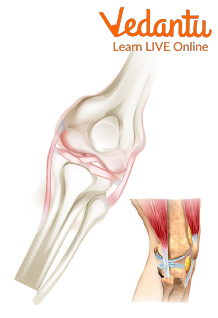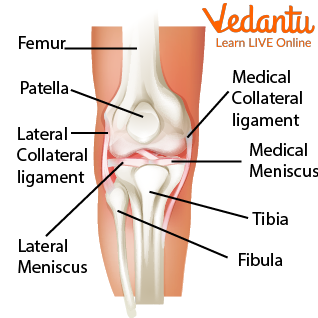




Types of Ligaments and Their Functions Explained for Students
Your joints' ligaments are bands of strong, elastic tissue. They bind bones together, support your joints, and restrict joint mobility. Your elbows, shoulders, knees, and other joints are all surrounded by ligaments. Your joints may become unstable when you stretch or tear them. A ligament in the human body is a strong, fibrous band of connective tissue that supports internal organs and keeps bones properly aligned at joints.
The fibrous bundles of collagenous fibres and fibrocytes, spindle-shaped cells with little ground material, make up a ligament (a gel-like component of the various connective tissues). Let’s figure out what ligaments are. In joints, ligaments in the human body create a capsular sac to house the articulating bone to bone joint ends and the synovial membrane, which serves as a lubricant.
A bursa is a pouch or recess that occasionally lines a structure with synovial tissue.

Ligaments in Joints
How many Ligaments are there in the Human Body and their Location?
Your body has more than 900 ligaments in all. Your arms and legs contain the majority of them. Ligaments resemble cords and are constructed from connective tissue, elastic fibres, and collagen, a protein that holds together tissues in mammals. Ligaments exist in a variety of sizes and forms. Most resemble bands, cords, or ropes. Others are broader while others are thin, like a strand of string. Some even have an arch form. They might be white, pink, or yellow.
A sprain, also known as an overstretch or ruptured ligament, can occur. Sprains are a frequent ailment, but there are certain preventative measures you can take to keep your ligaments stronger and safer.
Bone Joint
The points where two or more bones touch are called bone joints. The bones may move since the majority of joints are flexible. The following are the components of joints
Cartilage - This kind of tissue covers the bone's surface when a joint is present. The friction of movement within a joint is lessened by cartilage.
Synovial Lining - The synovial membrane, a kind of tissue, lines the joint and creates a joint capsule. To lubricate the joint, the synovial membrane secretes synovial fluid, a transparent, gooey substance.
Ligaments - To provide support and restrict joint mobility, strong ligaments (stiff, elastic bands of connective tissue) surround the joint. A bone joint happens to be secured by a ligament.
Tendons - On either side of a joint, muscles that regulate the movement of the joint are connected by tendons, another form of hard connective tissue. Tendons link bones and muscles.
Largest Joint in the Human Body
The place where bones of the lower and upper legs converge is the knee. The knee, which is the largest joint in the human body, allows you to sit, squat, walk, and leap because it moves like a hinge. Three bones make up the knee: the femur, often known as the thigh bone or upper leg bone.

The Human Knee and the Importance of Joint
Summary
Ligaments provide several crucial functions that aid in appropriate movement. They permit the joint to move in the direction or directions that it was designed to, bind bones together, ensure that no joints twist, stabilise the bones and muscles, bolster joints, and prevent the dislocation of bones. The area of the body where two or more bones unite to allow for movement is known as a joint. In general, the wider the range of motion, the greater the danger of damage since the joint's strength is diminished. Ball and socket, saddle, hinge, condyloid, pivot, and gliding are among the six varieties of freely moveable with the help of bone-to-bone joints.
FAQs on Ligaments in the Human Body: Meaning, Role & Importance
1. What are ligaments in the human body and what is their main function?
Ligaments are short, tough, and flexible bands of dense fibrous connective tissue. Their primary function is to connect one bone to another bone within a joint. This connection provides crucial stability to the joint, limits its range of motion to prevent injury, and ensures that bones move correctly relative to each other.
2. What type of tissue are ligaments made of?
Ligaments are composed of a specialised connective tissue. This tissue is primarily made up of tightly packed collagen fibres, which give ligaments their immense strength. They also contain some elastin fibres, which provide a degree of elasticity, allowing them to stretch slightly without tearing under normal stress.
3. How do ligaments differ from tendons?
Students often confuse ligaments and tendons, but they have distinct functions and compositions. The key differences are:
- Connection: Ligaments connect bone to bone, stabilising a joint. Tendons connect muscle to bone, enabling movement when a muscle contracts.
- Composition: Ligaments have more elastin fibres than tendons, making them more elastic. Tendons are tougher and more inelastic to efficiently transmit force from muscles.
- Function: Ligaments are for stability. Tendons are for movement.
4. What are some important examples of ligaments in the body?
The human body has over 900 ligaments. Some of the most well-known examples include:
- The Anterior Cruciate Ligament (ACL) and Posterior Cruciate Ligament (PCL) in the knee, which prevent the shin bone from sliding too far forward or backward.
- The annular ligament of the elbow, which holds the radius and ulna bones of the forearm together.
- The periodontal ligament, which is unique as it connects the tooth to its bony socket in the jaw.
5. Are all ligaments in the body the same, or are there different types?
No, not all ligaments are the same. They can be broadly classified into two types based on their composition:
- White Ligaments: These are rich in strong, inelastic collagen fibres. They provide immense stability but do not stretch much, like the ligaments in the knee.
- Yellow Ligaments: These contain a higher proportion of elastin fibres, making them noticeably elastic. An example is the ligamentum flavum, which connects the vertebrae in the spine and allows for bending and stretching of the back.
6. Why is a ligament sprain or tear considered a serious injury?
A ligament injury, such as a sprain or tear, is considered serious because ligaments have a very poor blood supply. This lack of blood flow means that the delivery of oxygen and nutrients needed for repair is extremely slow. Consequently, ligaments heal much more slowly than other tissues like muscle or bone, and often they do not regain their original strength, leading to long-term joint instability.
7. How do ligaments heal, and why is the process so slow?
The healing process for ligaments is slow and often incomplete due to their avascular nature (limited blood supply). Healing occurs in three phases: an initial inflammatory phase, a proliferative phase where new collagen is made, and a remodelling phase. However, the new tissue formed is essentially scar tissue, which is structurally weaker and less organised than the original ligament tissue. This is why a sprained joint may remain weaker or more prone to re-injury.
8. What would happen if the human body did not have ligaments?
If the human body lacked ligaments, our entire skeletal system would be dysfunctional. Joints would be incredibly unstable, as there would be nothing holding the bones together in their correct alignment. Any movement would likely result in immediate dislocation. Simple actions like walking, running, or even standing would be impossible, as the skeleton would not be able to support the body's weight or coordinate movement in a controlled manner.









